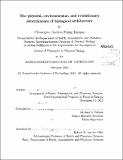The physical, environmental, and evolutionary determinants of biological architecture
Author(s)
Kempes, Christopher Andrew Poling
DownloadFull printable version (21.48Mb)
Other Contributors
Massachusetts Institute of Technology. Department of Earth, Atmospheric, and Planetary Sciences.
Advisor
Michael J. Follows.
Terms of use
Metadata
Show full item recordAbstract
The relationship between structure and function is a longstanding and central topic in biology, evolution, and ecology. The importance of morphology is clearly visible in the diverse forms taken by innumerable organisms in order to perform a myriad of functions. Examining the great variety of morphological characteristics it would seem that the overall principle of evolution is the only way to generalize the observed diversity: given differences in environments and random biological variation a great multitude of body plans have been invented as adaptations to many dynamic habitats given specific evolutionary histories. In this thesis I will show how focusing on diverse organisms makes it possible to identify common first-order laws of evolutionary organization. More specifically I will show how these common laws derive from a connection between organism structure, physical limitations, environmental constraints, and basic metabolic, biochemical, or energetic principles. Furthermore, I will show how this top level of biological organization holds significant predictive power for regional ecology and for interpreting the general trends of evolutionary history. In Chapter 2 we begin by deriving a model for the growth of single cells and populations of cells. This model is based on the partitioning of metabolic resources and the scaling relationship between metabolism and body size. We show that the growth of diverse classes of organisms is connected by common unit energetics. However there exist striking differences in the broad trends between growth rate and body size across these different classes and we show that this is a consequence of major evolutionary transitions which adjust the partitioning of metabolic resources. We interpret major evolutionary transitions to occur in response to energetic limitations. We also find that multicellular living for unicellular organisms provides a metabolic and reproductive advantage. In Chapters 3 and 4 we further investigate these features in microbial biofilms which exhibit rich spatial patterning. Using a mathematical model and experimentation we find that the tall vertical structures produced by these biofilms have optimal geometry for resource uptake and the growth efficiency of the entire colony. Our model allows us to predict the observed changes in feature geometry given alterations to the environmental conditions that the biofilms are grown in. Furthermore, we are able to show that the morphology of these structures is dependent on single cell physiology. For example, single genetic knockouts of flagellar motility radically alter the temporal dynamics of feature spacing. Our work highlights morphology as a central property in multicellular organisms which mediates the interaction between environmental conditions and physiology. In Chapter 5 we highlight the importance of morphology in complex multicellular life where we develop a general model of tree architecture which we link to physiological success within a given environment. Although this model is general, uses only tree size as a governing parameter, and does not consider speciation we are able use local resource availability to predict broad regional patterns in plant traits such as maximum tree height. Each of these chapters highlights the importance of structure and morphology at multiple biological scales. In Chapter 6 we show how the importance of structure extends to the genetic level where the specific encoding of a gene can have implicit information and functionality beyond the basic translation of codons. We investigate the observed implicit function of dramatic and frequent changes in the mutation rate of an organism given the structure of the mutL gene. We show mathematically that altering mutation rates is an evolutionarily advantageous strategy, and we show bioinformatically that the specific genetic structure that gives rise to this trait is under positive evolutionary selection.
Description
Thesis (Ph. D. in Physical Biology)--Massachusetts Institute of Technology, Dept. of Earth, Atmospheric, and Planetary Sciences, 2013. Cataloged from PDF version of thesis. Includes bibliographical references (p. 201-224).
Date issued
2013Department
Massachusetts Institute of Technology. Department of Earth, Atmospheric, and Planetary SciencesPublisher
Massachusetts Institute of Technology
Keywords
Earth, Atmospheric, and Planetary Sciences.